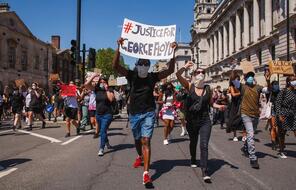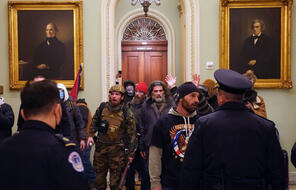Eugenics, Race, and Marriage
At a Glance
Language
English — USSubject
- Civics & Citizenship
- History
- Social Studies
- Racism
This reading comes from the Facing History & Ourselves resource Race and Membership in American History: The Eugenics Movement.
In challenging students to choose a mate carefully, George William Hunter, author of The New Civic Biology, a textbook first published in 1914, implied that it was an individual choice. And for some individuals like the young men from Michigan described in the reading, it was. In other parts of the United States, the government had a voice in that decision, as Richard Loving and Mildred Jeter would discover.
Loving and Jeter grew up in Virginia’s rural Caroline County in the 1950s. They met at a dance and dated for a few years before deciding to marry. After a wedding in Washington, D.C., they returned to Virginia to start a family. Historians Peter Irons and Stephanie Guitton write:
Six weeks later, the Lovings had a terrible shock. Sheriff Garnet Brooks arrived with a warrant directing him to bring “the body of said Richard Loving” before a judge. He dragged the Lovings out of bed. And what was their crime? Rich was white and Mildred had mixed black and Indian ancestry. Their marriage violated a Virginia law providing that “if any white person intermarry with a colored person”— or vice versa—each party “shall be guilty of a felony” and face prison terms of five years.
The Lovings pleaded guilty to avoid prison. Judge Leon Bazile suspended a one-year sentence if they agreed to leave Virginia for twenty-five years. The Lovings moved to Washington, but they were country people and couldn’t adjust to city life. They came back to Caroline County and lived a fugitive life for nine years, sheltered by family and friends and raising three small kids. “I never expected . . . such a beating,” Rich said later. “It was right rough.”
Rich appealed for help to Attorney General Robert Kennedy in 1963. Kennedy sent his letter to the American Civil Liberties Union, which recruited two Virginia lawyers, Philip Hirschkop and Bernard Cohen. They [argued] that the Lovings’ conviction [violated] the Fourteenth Amendment’s guarantee of “equal protection of the laws” to Americans of all races. Civil rights and church groups [supported] the appeal. 1
In 1967, the case now known as Loving v. Virginia reached the Supreme Court. Ten days after the couple’s ninth wedding anniversary, the justices issued a unanimous opinion: Virginia’s law was unconstitutional. This ruling also overturned anti-miscegenation laws—laws that banned marriages between whites and individuals of other “races”—in fifteen other states. Chief Justice Earl Warren stated the court’s opinion:
Marriage is one of the “basic civil rights of man,” fundamental to our very existence and survival. . . . To deny this fundamental freedom on so unsupportable a basis as the racial classifications embodied in these statutes . . . is surely to deprive all the State’s citizens of liberty without due process of law. The Fourteenth Amendment requires that the freedom of choice to marry may not be restricted by invidious racial discriminations. Under our Constitution, the freedom to marry, or not marry, a person of another race resides with the individual and cannot be infringed by the state.
Anti-miscegenation laws date back to colonial times. The first such statute was passed by the Maryland General Assembly in 1691. Other colonies followed suit. These laws were an American invention.There was no ban on interracial marriage in England at the time. By the late 1800s, 38 states had anti-miscegenation statutes. As late as 1924 these laws were on the books in 29 states. Anti-miscegenation laws varied greatly in the way they defined whom one could and could not marry. In a legal brief filed in Loving v. Virginia, the National Association for the Advancement of Colored People (the NAACP) commented on the inconsistencies in these laws:
In Mississippi, Mongolian-White marriages are illegal and void, while in North Carolina they are permitted. . . . In Arkansas, a Negro is defined as any person who has in his or her veins “any Negro blood whatever”; in Florida, one ceases to be a Negro when he has less than “one-eighth of African or Negro blood,” and in Oklahoma, anyone not of the “African descent” is miraculously transmuted into a member of the white race.
A number of states updated their anti-miscegenation laws in the 1920s. The Virginia Racial Integrity Act of 1924, which the Lovings violated, is a good example. Its sponsors used eugenic arguments to justify restrictions. They argued that interracial relationships are “dysgenic unions” in which “the superior group (whites) risks polluting their germ plasm with inferior hereditary traits.” Lothrop Stoddard, a lawyer and self-proclaimed eugenics expert, supported the proposed law. He told Virginia lawmakers:
White race purity is the cornerstone of our civilization. Its mongrelization with non-white blood, particularly with Negro blood, would spell the downfall of our civilization. This is a matter of both national and racial life and death, and no efforts would be spared to guard against the greatest of all perils—the perils of miscegenation. 2
On March 20, 1924, state lawmakers passed the Virginia Racial Integrity Act by a wide margin, and the governor signed it into law. The Virginia law remained on the books until 1967 when the Supreme Court overturned it in Loving v. Virginia. The law stated in part:
Section 1-14 of the Virginia Code: Colored persons and Indians defined—Every person in whom there is ascertainable any Negro blood shall be deemed and taken to be a colored person, and every person not a colored person having one fourth or more of American Indian blood shall be deemed an American Indian. . . .
Section 20-54 of the Virginia Code: Intermarriage prohibited; meaning of term ‘white persons.’—It shall hereafter be unlawful for any white person in this State to marry any save a white person, or a person with no other admixture of blood than white and American Indian. For the purpose of this chapter, the term ‘white person’ shall apply only to such person as has no trace whatever of any blood other than Caucasian; but persons who have one-sixteenth or less of the blood of the American Indian and have no other non-Caucasic blood shall be deemed to be white persons. . . .
Section 20-58 of the Virginia Code: Leaving State to evade law —If any white person and colored person shall go out of this State, for the purpose of being married, and with the intention of returning, and be married out of it, and afterwards return to and reside in it, cohabiting as man and wife, they shall be punished as provided in §20-59, and the marriage shall be governed by the same law as if it had been solemnized in this State. The fact of their cohabitation here as man and wife shall be evidence of their marriage.
Section 20-59 of the Virginia Code: Punishment for marriage.—If any white person intermarry with a colored person, or any colored person intermarry with a white person, he shall be guilty of a felony and shall be punished by confinement in the penitentiary for not less than one nor more than five years.
Walter Plecker, a physician and the director of the Virginia Board of Vital Statistics, was responsible for the enforcement of the law in the early 1900s. He and his staff relied on birth certificates, marriage licenses, tax records, and gossip to decide who was white and who was not. Plecker “corrected” birth certificates if he thought a person was trying to “pass” as white. He targeted Native Americans in the belief that they were really blacks trying to pass as something else. The pride Plecker took in his work is evident in a letter he wrote in 1943, during World War II: “Our own indexed birth and marriage records, showing race, reach back to 1853. Such a study has probably never been made before. . . . Hitler’s genealogical study of the Jews is not more complete.” 3
Connection Questions
- The word miscegenation comes from two Latin words—miscere, which means “mix” and genus for “race.” What is miscegenation? What is the purpose of an anti-miscegenation law?
- Over the years, the Supreme Court has identified a number of rights that are “so rooted in the traditions and conscience of our people as to be ranked as fundamental.” Why does the Court consider the right to marry “fundamental”? What other rights are viewed as “fundamental”?
- Why do anti-miscegenation laws regard interracial marriages as a “public health” issue? What arguments did Lothrop Stoddard offer the General Assembly in favor of the proposed Virginia Racial Integrity Act? What scientific arguments might you offer to counter his argument? What moral or philosophical arguments were offered in support of the law? How would you respond to them? If possible, refer to particular provisions in the law.
- American Indian groups in Virginia, including the Monacan tribe in Amherst County, are still feeling the consequences of Plecker’s interpretation of the Virginia Racial Integrity Act. They have been unable to persuade the federal government to recognize them as tribes because Plecker erased all evidence of their heritage. Some have called it “a paper genocide.” What does it mean to have your heritage—a part of your identity—erased?












